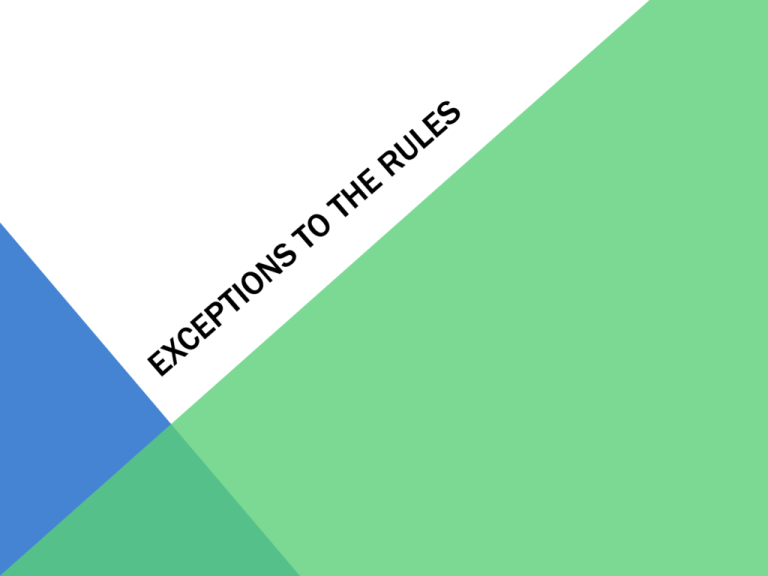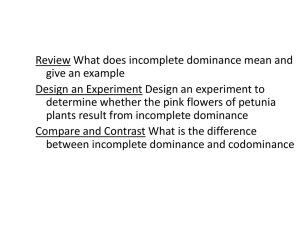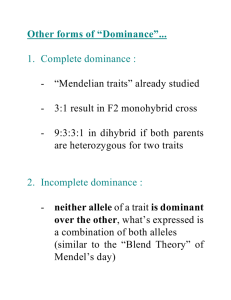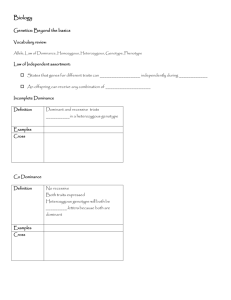Incomplete Dominance & Codominance
advertisement

REVIEW OF MENDEL’S PRINCIPLES Genes are passed parents offspring; get one allele from each parent EXCEPTIONS TO MENDEL’S PRINCIPLES Mendel’s principles offer a set of rules with which to predict various patterns of inheritance. There are exceptions to every rule, and exceptions to the exceptions. What happens if one allele is not completely dominant over another? What if a gene has several alleles? What are some exceptions to Mendel’s principles? Some alleles are neither dominant nor recessive. Many genes exist in several different forms, and are therefore said to have multiple alleles. Many traits are produced by the interaction of several genes. 1.INCOMPLETE DOMINANCE Cases in which one allele is not completely dominant over another are called incomplete dominance. In incomplete dominance, the heterozygous phenotype lies somewhere between the two homozygous phenotypes. Third phenotype that is a blending of the parental traits. (2 alleles produce 3 phenotypes.) Example: straight hair, wavy, curly EXAMPLE A cross between two four o’clock plants shows a common exception to Mendel’s principles. The F1 generation produced by a cross between red-flowered (RR) and white-flowered (WW) plants consists of pink-colored flowers (RW), as shown. Examples: Trait: Flower Color Expressions: Red x White Pink RR= Red; RW= pink; WW= white Incomplete Dominance CODOMINANCE Cases in which the phenotypes produced by both alleles are clearly expressed are called codominance. For example, in certain varieties of chicken, the allele for black feathers is codominant with the allele for white feathers. Heterozygous chickens have a color described as “erminette,” speckled with black and white feathers. Both alleles contribute to the phenotype. Example: In come chickens Black Chicken x White Speckled Chicken YOU TELL ME WHICH TYPE OF DOMINANCE… Codominance! TYPE OF DOMINANCE? Incomplete Dominance! TYPE OF DOMINANCE? Incomplete Dominance! 3. PLEIOTROPY • Occurs when a single gene influences multiple phenotypic traits. • Consequently, a new mutation in the gene will have an effect on all traits simultaneously. This can become a problem when selection on one trait favors one specific mutant, while the selection on the other trait favors another mutant. • The ability of a single gene to have multiple effects. 4. EPISTASIS o The interaction between two or more genes to control a single phenotype. o Epistasis occurs when more than one gene is needed to control one trait. o Phenomenon in which one gene alters the expression of another that is independently inherited. 5. POLYGENIC TRAITS • Traits that are determined by multiple genes for a characteristic. • Traits controlled by two or more genes are said to be polygenic traits. • Polygenic means “many genes.” • Often show a wide range of phenotypes. The variety of skin color in humans comes about partly because more than four different genes probably control this trait. 6. MULTIPLE ALLELES • A single gene can have many possible alleles. • A gene with more than two alleles is said to have multiple alleles. • Many genes have multiple alleles, including the human genes for blood type. This chart shows the percentage of the U.S. population that shares each blood group.







